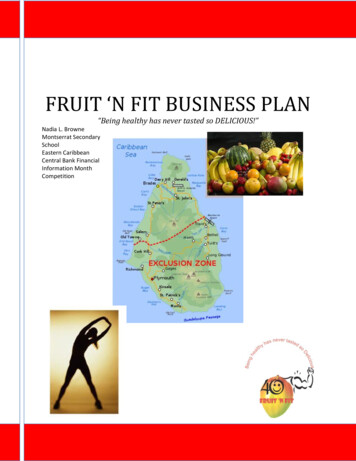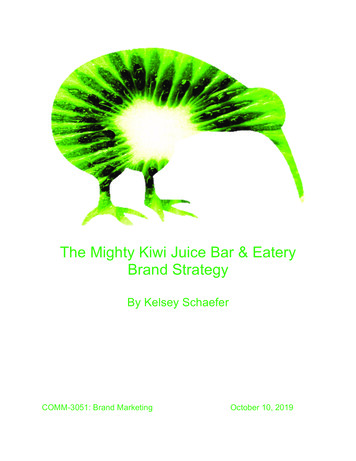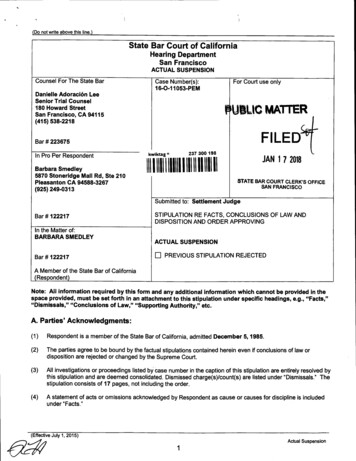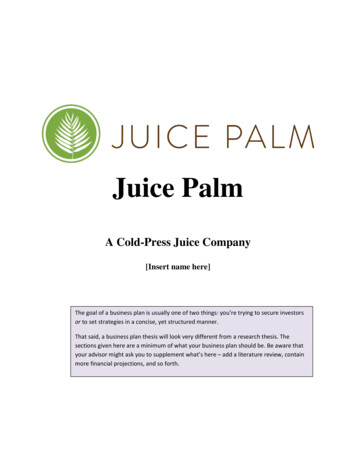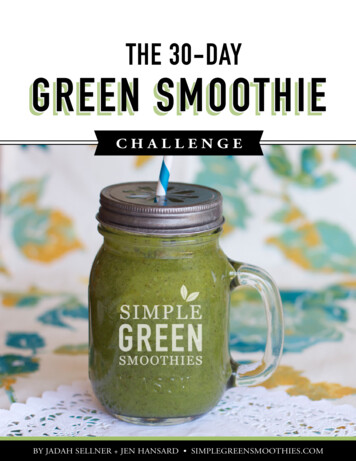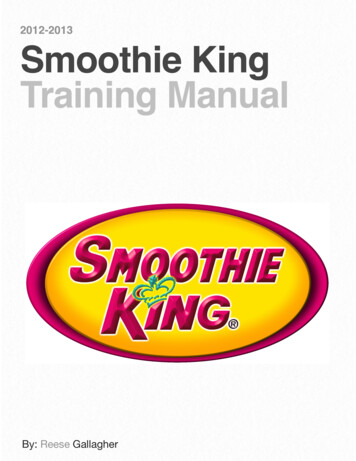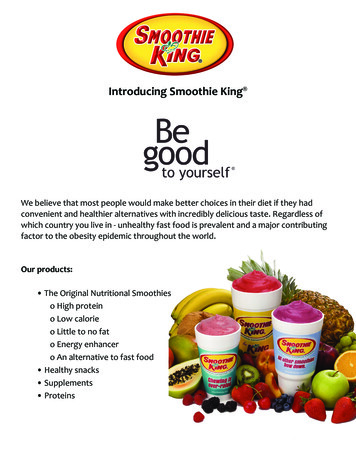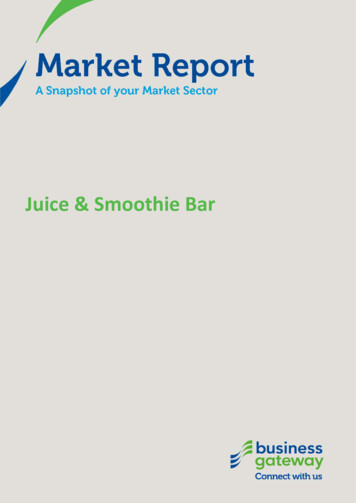
Transcription
Juice & Smoothie Bar
This pack has been designed to provide information on setting up a business in the Juice & Smoothie Bar industryin Scotland, as well as helping to inform the market research section of your business plan. You can find moreinformation on how to write a business plan from the Business Gateway website(www.bgateway.com/businessplan), including an interactive template and tips to get you started.This market report was updated by Business Gateway in July 2018. If you find the information contained in thisdocument useful, tell us about it! Send us feedback here; we will use your comments to help improve our service.What do I need to know about the Juice & Smoothie Bar market?The following summary statistics have been taken from market research reports and reliable resources that theInformation Service uses to compile industry information. They should give you an indication of how your industryis faring at present and whether there is demand for your type of business: Estimated at 5.1 billion in 2017, total sales of fruit juice, juice drinks and smoothies grew by 6.6% over2012-17, while volumes saw a decline of 9.6%. An increase in average price has propped up sales, whileconsumer confusion over sugar has seen cutbacks in usage of fruit juice continue (Mintel, Fruit Juice, JuiceDrink and Smoothies, November 2017). The industry is expected to continue to grow strongly at a compound annual rate of 5.4% over the nextfive years, to reach 100 million in 2022-23, as the number of new stores surges and consumer demandfor healthy, convenient beverages rises. Increasing health consciousness is anticipated to result inoperators expanding their range of products, introducing juices and smoothies that contain ingredientslike superfruits, additives, vegetables and coffee (IBISWorld, Juice & Smoothie Bars, October 2017). The Juice Production industry has been squeezed over the past five years. Mounting concerns about thehigh sugar content of fruit juice have weighed on sales since 2013-14. Revenue is expected to contract by1.8% in 2017-18, with fruit juice sales significantly underperforming those of soft drinks and otherbeverages (IBISWorld, Juice Production in the UK, October 2017). In 2020, the United Kingdom juices market is forecast to have a value of 2,769.6 million, a decrease of11.1% since 2015. The United Kingdom accounts for 19.1% of the European juices market value. The UKjuices market is concentrated, with the top four leading players accounting for 60.3% of the market’svalue, indicating moderate levels of rivalry between players (Marketline, United Kingdom – Juices,November 2016). The national organisation for this industry is British Fruit Juice Association. Other industry bodies includeFood & Drink Federation, British Soft Drinks Association, British Hospitality Association and Scotland Food& Drink.
Where can I find more information on my market?The Information Service has access to a number of databases which can offer more detail on this industry. Someof these reports are listed below - if you would like to be sent extracts from any of these reports, please contactus on 0300 013 4753 or email info@bgateway.com. Mintel – Fruit Juice, Juice Drinks and Smoothies (November 2017). Fruit juices and smoothies have notbeen able to avoid scrutiny over their sugar content, however, marketing has started to focus on thehealth benefits offered by these drinks such as their vitamin content in a bid to shift the attention awayfrom sugar. Meanwhile NPD has looked to improve their health credentials with a focus on ‘positivenutrition’, such as through adding vegetables or other ingredients enjoying media buzz as healthy. IBISWorld – Juice & Smoothie Bars in the UK (October 2017). Revenue growth has been driven byincreases in health awareness and consumer demand for healthy, convenient, on-the-go beverages. Overthe past five years, Fuel Juice Bars Ltd has expanded rapidly, increasing from eight stores in 2011 to 39 in2017, which has boosted industry revenue. There has also been an increase in the number of smallindependent operators and as a result, the number of establishments is expected to nearly triple over the10 years through 2022-23. Industry profitability is high, though some major players have reportedgrowing pressure from competition, increasing input costs and high levels of investment in new stores. IBISWorld – Juice Production in the UK (October 2017). Demand for fruit and vegetable juice is largelydependent on consumer taste and the level of health consciousness. Demand is also sensitive to price,since the industry's products are relatively homogenous. Moreover, fruit and vegetable juices arediscretionary items. Therefore, when disposable income is high, consumers are more likely to purchasethe industry's products.There are also a number of online resources you may find helpful: The Telegraph, Fruit juice ban for ads aimed at children in sugar crackdown, March 2018(tinyurl.com/y7f39tpr). The vast majority of fruit juices will be banned from advertising aimed at childrenin a bid to cut down on juvenile obesity, the Government has proposed. Scottish Grocer, Juice the answer at breakfast time, May 2017 (tinyurl.com/ycar35n3). Chilled fruitjuice generates 60% of total juice sales, says Pepsico, and, quoting Nielsen research, it says sales arecurrently growing at 1.7% with sales in the impulse channel doing even better and growing at 2%. British Soft Drinks Association, Making it Happen, Annual Report 2017, November 2017(tinyurl.com/y86xyllq). This report provides an overview of the industry and latest developments.Disclaimer: please note that this research may contain copyrighted material. Copyright belongs to the holderscredited above and, as such, recipients of this research reproduce and repurpose this information at their ownrisk.
How can I find out about my competitors?Business Gateway’s online guide to Competitor Analysis explains how to find your competitors, how to researchwhat they’re doing and how to act on what you learn about them.Immediate competition will be from other businesses in your local area. There are several online directorieswhich can be used to find company information and generate lists easily and at no expense. Many LocalAuthorities also publish local business directories on the web. Below are some key web resources: General business directories such as Yell, Thomson Local or Google MapsTrade specialists like EuroPages (European directory), The Wholesaler or Free IndexBusiness to business (B2B) specialists such as KompassLikewise, your local Chamber of Commerce may publish a members’ directory; find your local Chamber on theScottish Chambers website.Once you’ve identified who your competitors are, the next step is to gather information on the way they dobusiness. Which services do they provide? How do they market themselves? How much do they charge?To learn about your competitors: Look for articles or adverts in local newspapers, trade press and directories. Search for information on limited UK companies via the Companies House websiteTry to read their marketing material; if the company has an online presence, visit the company’s websiteas a first port of call. Not only does it give you a better understanding of the company’s activities, it canalso offer a wealth of information such as a company history or staff biographies, as well as thecompany’s partners or suppliersGain an insight into your competitor’s performance using credit checks and the accounts that limitedcompanies are required to submit to Companies House each year.We can provide credit checks free of charge; if you are interested in using this resource, or looking for us to helpyou find relevant publications, please contact us by emailing info@bgateway.com or by calling 0300 013 4753
What about suppliers?Choosing and Managing Suppliers can help you decide what you need from a supplier, how to identify one andhow to choose one to deal with.Trade associations or industry specific organisations may also be able to recommend suppliers or contacts. Youcan also use the aforementioned resources for finding competitors to find suppliers.Once you have decided on a supplier, we can run a credit check on the company to help assess their financialstability. We provide credit checks free of charge; if you are interested in using the resource pleaseinfo@bgateway.com or by calling 0300 013 4753.Who are my customers?Your business plan should include information about the customers you would expect. Business Gateway’s guideson Retaining and Grow Your Customer Base (tinyurl.com/c2fw4o4) will help you to identify who your customersare, how to use this information to sell more effectively and how to actively compete in your marketplace.It can be useful to group your customers by geographical location, age or lifestyle. The websites listed below arefreely available and can provide most of this information. If you can’t find what you’re looking for from thesewebsite, please contact us and one of the team will be happy to help: Access the latest population estimates from the National Records of Scotland (NRS). NRS also offersdemographic factsheets for each council area in Scotland, which can provide summary statistics for thearea you will be based in.Information from the most recent census in 2011 is released via the official website. See in particular theCensus Area Profiles. Clicking on your area of interest will give the latest population figures, includingestimates by age.Understanding Scottish Places has interactive profiles of towns and cities across Scotland. It can be usefulfor understanding the interrelationships and flows between towns, and also gives comparisons betweentwo or more places.Scottish Government Statistics provide accurate and up-to-date statistics on Scotland, coveringpopulation, health, education and housing.The Scottish Household Survey provides information on the structure, characteristics, attitudes andbehaviour of Scottish households, both at a national and local level.Office for National Statistics (ONS) is the recognised national statistical body for the UK. ONS covers awide range of demographic, economic and social issues at a UK level.
How can you help me with other aspects of starting my business?The Business Gateway website has guides, videos, online tutorials and tips on all aspects of starting up a businessin Scotland. Follow the links below to explore each resource:AccountancyPricingInstitute of Chartered Accountants of Scotland’s(ICAS) “Find a Chartered Account” toolBusiness Companion Pricing & payment guide.Please note: the most effective way to researchpricing is to conduct your own research – visitwholesalers or suppliers to obtain price lists, findquotes from similar companies and work out whatother businesses in your area are chargingFundingPractical information on finance and funding forstarting and growing your businessInsuranceBusiness insurance guideLegal HelpGov.uk “Licence Finder” toolLaw Society of Scotland’s “Find a Solicitor” toolPromotionBG guides to MarketingTrainingSkills Development Scotland’s My World of WorkFunding for trainingSmall Business Bonus Scheme (Scotland)Your local Business Gateway can offer events, workshops and 1:2:1 support on all aspects of starting anddeveloping your business. Call the helpline on 0300 013 4753 to find out what is available in your area.We hope you find this Market Report useful and we’d love to hear your feedback here.Last updated: July 2018Updated by: Rebecca
Juice & Smoothie Bars, October 2017). The Juice Production industry has been squeezed over the past five years. Mounting concerns about the high sugar content of fruit juice have weighed on sales since 2013-14. Revenue is expected to contract by 1.8% in 2017-18, with fruit juice sales significantly underperforming those of soft drinks and other
